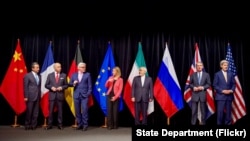The comprehensive plan of action between Iran and world powers is designed to significantly curb Iran’s ability to produce nuclear weapons while providing phased sanctions relief.
Under the plan, Iran will limit uranium enrichment and enrichment-related activities. It also agrees to phase out some of its centrifuges – machines used for uranium enrichment.
Further, Iran will not conduct research and development activities that could contribute to the development of a “nuclear explosive device.”
Break-out time
The deal is designed to increase the amount of time that Iran would need to produce a nuclear weapon from a few months to a year, the so-called break-out time. However, if this violation of the agreement did occur, world powers say they are prepared to take steps to re-impose sanctions.
While the agreement covers nuclear-related economic and financial sanctions, it does not cover other restrictions on Iran, such as U.S. sanctions for what it says is Iran’s support of terrorism, as well as penalties for human rights abuses.
Also, a U.N. arms embargo on conventional weapons would eventually be lifted, if Iran reaches the goals of the agreement.
The International Atomic Energy Agency (IAEA) will monitor Iran’s compliance with provisions in the agreement, partly through inspections.
The plan also calls for the establishment of a joint commission that will monitor the implementation of the agreement.
4 pathways
In a statement, the White House said the deal between Iran and the five permanent members of the U.N. Security Council and Germany would block Iran’s four “pathways” to a nuclear weapon. Those pathways are highly enriched uranium at Iran’s Natanz and Fordow facilities, the ability to produce weapons-grade plutonium and “covert” attempts to produce fissile material.
President Barack Obama said Iran currently had a stockpile that could “produce up to ten nuclear weapons.” The agreement would reduce that stockpile to “a fraction of what would be required for a single weapon,” said Obama.
In a background briefing, senior administration officials said the president had instructed U.S. negotiators in Vienna to avoid focusing on deadlines but instead focus on getting a “quality deal.” Some members of the U.S. negotiating team have been in Vienna for over a month.
“There is no sense of time here anymore. The days and nights have all flowed together,” said one senior administration official about the marathon talks.
According to Iranian state media, President Hassan Rouhani noted that since he took office, he had been saying “The West would have engagement,” with Iran if it “quits the language of threat and humiliation.” He commented in a nationally televised address.
Non-proliferation agreement
The deal is a non-proliferation agreement, said Ploughshares Fund policy director Tom Collina, a nuclear weapons and missile defense expert.
“Through this agreement, they will not have the physical ability to do it without being caught over the next ten years,” he said.
“The risks of having this agreement are significantly less than having no agreement whatsoever,” said James Acton, the Nuclear Policy Program co-director at the Carnegie Endowment for International Peace.
“This agreement appears to contain pretty stringent limits on Iran’s program, pretty stringent verification provisions,” he said.
Secretary of State John Kerry, who has spent more than two weeks at the Vienna negotiators, said “confidence is never built overnight.”
“It is developed over time,” he said.
Kerry said none of the sanctions would be lifted until Iran implements commitments. He also said that some restrictions on Iran would remain in place for years to come.













